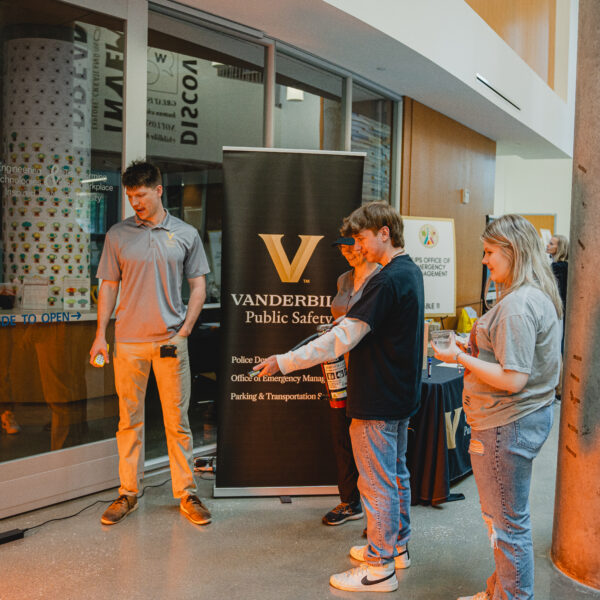
Given the occurrence of tragic accidents and near-misses at research institutions across the country, cultivating a culture of laboratory safety in academic institutions has been a pressing concern for governmental funding agencies. Thanks to a training grant supplement from the National Institute of General Medical Sciences awarded last year, Vanderbilt campus partners collaborated to execute a thorough and effective laboratory safety pilot program to educate and inform students about the importance of lab safety.
Initiated by Madhvi Venkatesh, assistant professor of biochemistry and curriculum director of the Interdisciplinary Graduate Program, the lab safety pilot program was a partnership between the Cellular, Biochemical, and Molecular Sciences training program, the Biomedical Research Education and Training Office, and the Environment Health, Safety, and Sustainability department.
According to Venkatesh, this effort, which resulted in both a course module and a research safety fair, focused on bridging the gap between the existing institutional safety trainings and actual implementation in the labs. The research safety fair complemented the module because CBMS and partners recognized that researchers at all levels—and not just students—need to work together to help create safe lab environments. “There was an emphasis on making the module interactive and using examples from the students to help make the teachings directly applicable to their research projects,” she said.
One aspect of the pilot program, the module titled “Developing a Lab Research Safety Mindset,” was taught by Robin Trundy, biological safety associate director and institutional biosafety officer at Vanderbilt. The module, which lasted four weeks and concluded in April, used didactic lectures, interactive activities, case studies, and peer discussions to help students better understand and apply lab safety principles. The course covered the application of risk assessment principles, identification of improper safety practices, and ways to integrate risk assessment into students’ research plans.
“Our goal for this module series was to equip students with knowledge of essential risk assessment concepts and empower them to proactively integrate safety practice considerations into future research designs,” Trundy said. “We are confident that this goal was achieved, and these individuals will not only protect themselves and others from hazards in the lab research setting but also be allies in building a lab safety culture at any institution they join in the future.”
The feedback from students who are part of CBMS and the Biochemical and Chemical Training for Cancer Research training programs in the module was overwhelmingly positive. For many, the module was highly effective in helping them incorporate risk assessment into their research project plans, and all of them said that they would recommend the current module.
According to Andrew Dixon, a graduate student in Alissa Weaver‘s lab, the module was instilled important laboratory safety measures. “We heard horror stories of research conduct gone wrong and discussed how to work responsibly and safely with hazards in similar situations,” he said. Dixon found the class to be a helpful refresher. “Although I’ve taken many biosafety modules before, I found that this one gave me a chance to ‘check in’ to make sure I’m working in a safe way,” he said.
The lab safety module will also be featured at the annual meeting of the American Association of Medical College’s Group on Research, Education, and Training.
The research safety fair, which took place on April 11, provided an opportunity for students to foster relationships and network with researchers, administrators, and safety teams. The interactive day featured various lab safety stations hosted by several university offices and offered participants the chance to learn about lab safety, hazardous material spill response, fire safety and extinguisher operation, incident reporting, and other research safety topics. Along with providing giveaways such as lab safety glasses, the fair provided participative instruction and efficient exposure to all aspects of lab safety.
“Our team has been delighted to collaborate with Basic Sciences and other university partners to enhance research safety and risk assessment education for our students,” said Andrea George, assistant vice chancellor for environmental health, safety, and sustainability. “We look forward to continuing to partner with our research community to encourage and innovate safe and sustainable environments in support of Vanderbilt’s mission of education, research, and discovery.”
The following offices/units hosted stations at the research safety fair:
- The Department of Environment Health, Safety, and Sustainability
- Office of Biomedical Research Education and Training
- Dean’s Office in the School of Medicine Basic Sciences
- Dean’s Office in the College of Arts and Sciences
- Dean’s Office in the College of Engineering
- Vanderbilt Human Research Protections Program
- Vanderbilt University Public Safety Office of Emergency Management
- Vanderbilt University Maintenance and Operations
- Wond’ry
- Vanderbilt University Medical Center Occupational Health
- VUMC Office of Clinical and Research Safety
- VUMC Animal Care and Use Program
- Vanderbilt Institute of Nanoscale Science and Engineering
The lab safety pilot program is under the leadership of Todd Graham and James Patton, both professors of cell and developmental biology and Stevenson Professors of biological sciences, and Katherine Friedman, professor and vice chair of biological sciences.